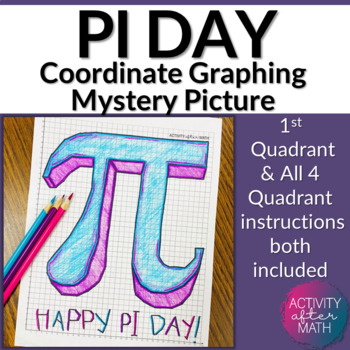Pi Day Coordinate Graphing Picture 1st Quadrant & ALL 4 Quadrants
- Zip
What educators are saying
Also included in
- This is a bundle of ALL Coordinate Graphing Mystery Pictures that are currently in my store. You are receiving over a 30% savings from purchasing this bundled product! **Please see the list below for exact pictures included!**Please note that the States Mystery Pictures are NOT included in this BundPrice $70.00Original Price $105.00Save $35.00
Description
This is a great activity where students graph points on a coordinate plane and it creates a picture of the Pi Symbol with Happy Pi Day at the bottom! The clever title of "Stop Being So Irrational!" gives them a clue to what the picture will be.
CLICK HERE to SAVE over 40% and get this in the HOLIDAY BUNDLE
I have included Student Instructions for both Quadrant One ONLY and instructions that include ALL four Quadrants! This is a great way to differentiate for your lower-level learners as well as your higher-level learners.
The points include ordered pairs with decimals such as (10, 4.5) and (-0.5, -1.5).
This resource includes:
For each version:
- A blank outline of the graph to use as an answer key.
- A colored example of the finished picture.
- Student Instructions with the ordered pairs.
- A graph with the numbers and x- and y-axis labeled.
- A graph with the fractional grid lines labeled. This is also great for differentiation!
Options for using this resource:
This makes a great Pi Day Math activity, Albert Einstein, Early Finisher, Sub plans, or filler activity. Students can create their own designs on their pi symbol. Students could write facts inside their symbol.
These make a great classroom decoration and look great as a bulletin board!
Click here to see my Blog Post on Celebrating Pi Day
It is easy to print the points on one side and the graph on the back to save paper! This is hand drawn, not computer generated, so the points graphed work out exactly as the picture looks!
You might also be interested in these resources:
St. Patrick's Day Coordinate Graphing Picture
Chicken Coordinate Graphing Picture
Middle School Math Anchor Charts BUNDLE
Sudoku Interactive Bulletin Board Kit
STATES Coordinate Graphing Pictures BUNDLE
Don't forget that leaving feedback earns you points toward FREE TPT purchases
© Hayley Cain (Activity After Math) Please note - this resource is for use by one teacher only. Additional teachers must purchase their own license. If you are interested in purchasing several licenses, please contact me. Thank you for your feedback and Happy Teaching!
hayley@activityaftermath.com
★Let's be Social






